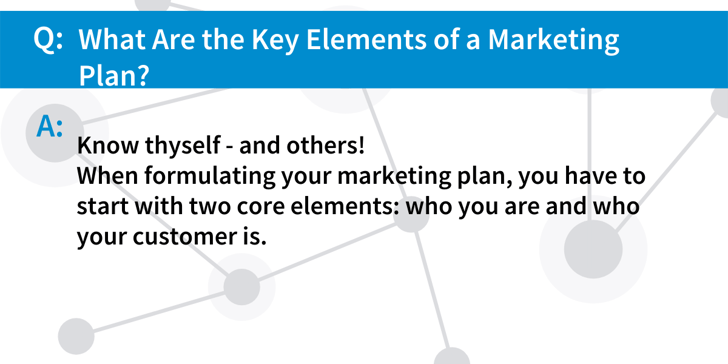What Makes a Good Marketing Plan?
December 7, 2020 •DJ Team

How do you write a marketing plan? What makes a marketing plan “good” or “bad?” When you sit down to make your content marketing plan, these are questions that can seem daunting. Let’s take a look at how to make this process work for you and not against you.
What are the key elements of a marketing plan?
Know thyself - and others!
When formulating your marketing plan, you have to start with two core elements: who you are and who your customer is. Look at your business critically and figure out your products and solutions that are at the center of why you do what you do. Another important step is to assess the marketing that you already do. What works? What isn’t really working? It may surprise you to find that you aren’t as familiar with your business as you thought—taking a good hard look and being honest about what is actually there will help you make a solid, effective marketing plan.
Next is knowing who your customer is. Who are the people that you are capturing right now? Are these the customers that you need and want? Determining who your target customer is will help you figure out how to perfectly tailor your marketing plan to reach them, no matter their demographic differences.
Finally, it’s also important to know who your competition is. Take a look at other businesses in your field and evaluate their marketing and customer following. What are they doing that you’re not? What are you doing that they aren’t? Where are the areas of overlap? All of these compare and contrast exercises will give you important insight into what types of things need to be in your content marketing plan.

Do your research
Don’t rely solely on your impressions and gut instinct when it comes to assessing your business and customers. Often our impressions can be misleading. Data is your best tool, and looking at the numbers of what people are actually clicking on (vs. what you *think* they’re clicking on) will help you as you write your content marketing plan. Online behavior is another important area - what are people searching for? How can your business solve the problems that people have?

Look at the big picture and the picture(s) hidden within
Now it’s time to actually put pen to paper. Write down your goals, your profile of who your target customer is—those big picture things that you identified. Then, once you’ve made the big picture plan, also known as an executive summary, it’s time to write out plans for the smaller pictures that are contained within. These are things like:
- paid marketing plan
- social media plan
- product/service launch plan
- quarterly or annual marketing plans
These are often calendars and timelines of when you will be pushing certain pieces of content out on different channels.
Mix it up!
There are two different areas that you should think about when writing your marketing plan, and both of them have 4 elements.
- Consider the 4 types of marketing strategies:
- cause marketing (linking a company and its products/services to a social cause or issue),
- relationship marketing (focused on strengthening the relationship between your customer and your business),
- scarcity marketing (creating a perception of a shortage so customers purchase quickly to avoid missing out), and
- undercover marketing (marketing in a way that customers don’t realize that they are being marketed to).
- Keep in mind the principal of marketing mix while formulating and thinking about your content marketing plan. These are often called the 4P’s - product (or service), place, price, and promotion. You’ll want to have a good variety of these different types of content to keep your marketing fresh and engaging for your customers.
Assess and adapt your marketing plan!
A good marketing plan is one that is never actually finished. Your marketing plan isn’t a “one and done” type of plan—ideally you should be constantly assessing and adapting your plan in order to keep it as effective and on-brand as possible. “Adapt or die,” as the saying goes, and while this rings true for your content marketing plan as well, a better way to say it is “adapt and THRIVE.” Thinking of your marketing plan as a living, evolving, growing document will help you create revenue and meet your goals.
Take The Guesswork Out of Your Content Marketing Plan!
As you can see, data is important for many parts of creating your marketing plan. It can take an enormous amount of time to uncover and utilize data to improve your ROI. DemandJump offers a fast and unique view of your marketing data so you can make informed and effective decisions with your content marketing plan. You’ll see your ROI improve as DemandJump can show you across all your channels and campaigns what is working...and what is a hidden cost eater. You can get automatic recommendations that will help you eliminate waste, improve performance, and continually assess and adapt your marketing strategies. Try a free trial of DemandJump and let us take the guesswork out of what to do next!
Featured Articles
Categories
- Attribution Tracking (13)
- Channel Optimization (11)
- Consumer Insights (68)
- Content Marketing (251)
- Data Science (8)
- Digital Marketing (6)
- Digital Transformation (26)
- Enterprise (10)
- Lead Generation (14)
- Market Intelligence (8)
- Marketing Analytics (39)
- Marketing Attribution (57)
- Marketing Management (153)
- Marketing Operations (86)
- Organic Search (222)
- Paid Search (52)
- Pillar-Based Marketing (63)
- Programmatic Advertising (9)
- SaaS Content (14)
- SaaS Marketing (29)
- Search Marketing (111)
- SEO Keyword Research (28)
- SEO Pillar (18)
- SEO Strategy (46)
- SMB (5)
- Website Content (12)

